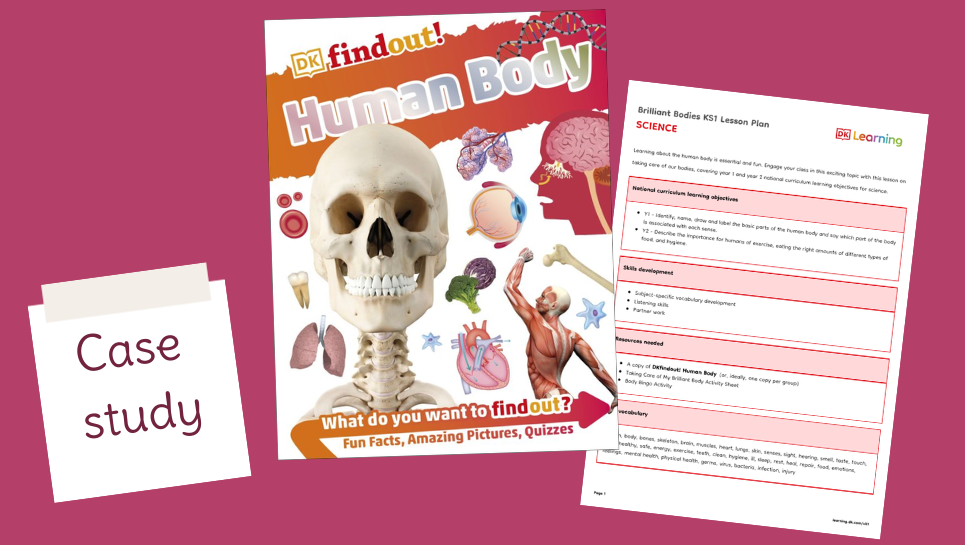case study
10 Oct 2023
by Kelsey Benham
Engaging Children in Non-fiction Books with the Brilliant Bodies Lesson Pack

I taught my Year 1 class about the human body right at the start of the school year. When I came across the DKfindout! Human Body book and accompanying Brilliant Bodies lesson pack, I decided to use them as a means of revisiting the learning. I was able to recap and assess the children’s knowledge and understanding months after initially covering the topic in science.
High-Quality Non-fiction
My colleagues and I thought the book was amazing. DK books are clearly high-quality texts, covering lots of content. They’re really visual for the children, with simply-written key information in text boxes and lots of great illustrations and photos.
For this age group, there’s not a huge amount of non-fiction texts out there, so it’s lovely to have a resource like this in the classroom that they engage so well with.
We gave each group a book, which they absolutely loved! Weeks later, the children are still choosing to look at the books in our reading corner, meaning they’re fuelling their curiosity, embedding their learning about the human body and developing their reading skills. They really enjoy the quizzes and games in the book, which make it more interactive and ideal for looking at with a friend.
Engaging, Adaptable and Accessible Lessons
It was really clear in the lesson plan what the learning objectives were. We particularly focused on the five senses, as this is a Year 1 science objective. Through the activities, I felt all the children were able to meet the learning objectives.
By the end of the lesson, I felt that all children had a really good understanding of the parts of the body we focused on and the important roles that each of those body parts have.
The lesson lasted just under an hour and it was perfectly pitched for my learners. There were different activities within the lesson, which meant they could get up and move around between tasks. This kept the children really engaged throughout.
I loved the fact that there was the opportunity to present their work in different ways. Not all children needed to write everything down; for those children who find writing more difficult, there was the option to show their learning in a different way.
The children worked in mixed-ability groups throughout the lesson. This supported them with the reading and worked really well for the bingo activity, where they played in mixed-ability pairs.
The class loved the bingo game, which we played again at the end of the day. That was a great way to really consolidate the learning in a fun way.
Going Beyond Assessing Pupils’ Science Knowledge
There was lots of opportunity for discussion at the beginning of the lesson and then again at the end. This supports speaking and listening skills and builds children’s confidence in taking part in discussions. They also developed their questioning skills, as they wanted to know more about the parts of the body that we hadn’t had time to cover in the lesson.
The fact that they loved the book so much also meant that they were keen to read (or attempt to read) sections, growing their independence with reading and their understanding that non-fiction books are a reliable source of knowledge.
We’ll use the books in guided reading sessions and be able to talk about the layout and organisation of information. Using the contents page during the lesson was also great for showing children how to locate specific information in non-fiction books.
Free Resources to Save Teachers Time
I think it’s brilliant that these teaching resources are free. As teachers, we spend so much time planning and searching for different things, so having a resource that’s ‘ready to go’ was amazing!
